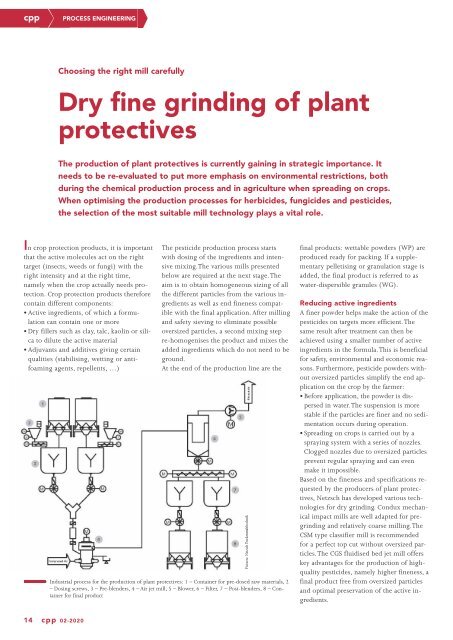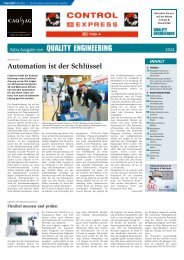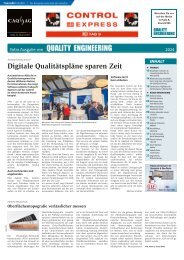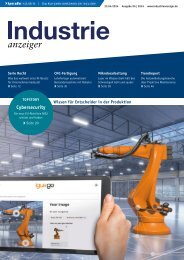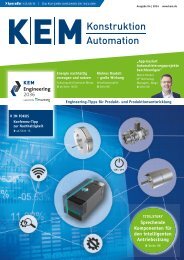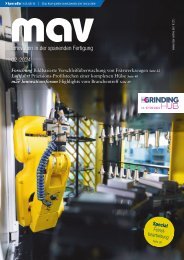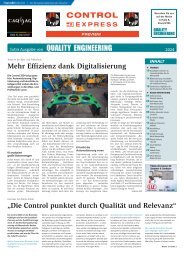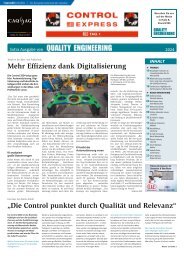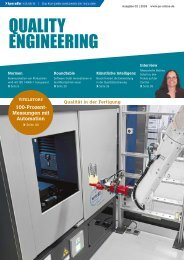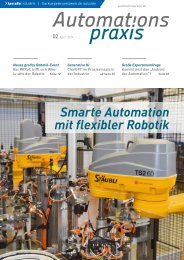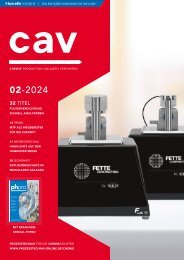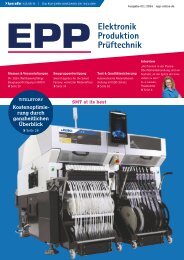cpp – Process technology for the chemical industry 02.2020
The journal cpp - Process technology for the chemical industry reports about processes, plants, apparatus and components for the chemical and pharmaceutical industry. Further topics are IT technologies, industry 4.0, digital production, MSR and automation technology and process analysis technology. The content spectrum is rounded off by explosion protection, plant safety, occupational health and safety, maintenance, site management and energy management.
The journal cpp - Process technology for the chemical industry reports about processes, plants, apparatus and components for the chemical and pharmaceutical industry. Further topics are IT technologies, industry 4.0, digital production, MSR and automation technology and process analysis technology. The content spectrum is rounded off by explosion protection, plant safety, occupational health and safety, maintenance, site management and energy management.
You also want an ePaper? Increase the reach of your titles
YUMPU automatically turns print PDFs into web optimized ePapers that Google loves.
<strong>cpp</strong><br />
PROCESS ENGINEERING<br />
Choosing <strong>the</strong> right mill carefully<br />
Dry fine grinding of plant<br />
protectives<br />
The production of plant protectives is currently gaining in strategic importance. It<br />
needs to be re-evaluated to put more emphasis on environmental restrictions, both<br />
during <strong>the</strong> <strong>chemical</strong> production process and in agriculture when spreading on crops.<br />
When optimising <strong>the</strong> production processes <strong>for</strong> herbicides, fungicides and pesticides,<br />
<strong>the</strong> selection of <strong>the</strong> most suitable mill <strong>technology</strong> plays a vital role.<br />
In crop protection products, it is important<br />
that <strong>the</strong> active molecules act on <strong>the</strong> right<br />
target (insects, weeds or fungi) with <strong>the</strong><br />
right intensity and at <strong>the</strong> right time,<br />
namely when <strong>the</strong> crop actually needs protection.<br />
Crop protection products <strong>the</strong>re<strong>for</strong>e<br />
contain different components:<br />
• Active ingredients, of which a <strong>for</strong>mulation<br />
can contain one or more<br />
• Dry fillers such as clay, talc, kaolin or silica<br />
to dilute <strong>the</strong> active material<br />
• Adjuvants and additives giving certain<br />
qualities (stabilising, wetting or antifoaming<br />
agents, repellents, …)<br />
The pesticide production process starts<br />
with dosing of <strong>the</strong> ingredients and intensive<br />
mixing. The various mills presented<br />
below are required at <strong>the</strong> next stage. The<br />
aim is to obtain homogeneous sizing of all<br />
<strong>the</strong> different particles from <strong>the</strong> various ingredients<br />
as well as end fineness compatible<br />
with <strong>the</strong> final application. After milling<br />
and safety sieving to eliminate possible<br />
oversized particles, a second mixing step<br />
re-homogenises <strong>the</strong> product and mixes <strong>the</strong><br />
added ingredients which do not need to be<br />
ground.<br />
At <strong>the</strong> end of <strong>the</strong> production line are <strong>the</strong><br />
Industrial process <strong>for</strong> <strong>the</strong> production of plant protectives: 1 <strong>–</strong> Container <strong>for</strong> pre-dosed raw materials, 2<br />
<strong>–</strong> Dosing screws, 3 <strong>–</strong> Pre-blenders, 4 <strong>–</strong> Air jet mill, 5 <strong>–</strong> Blower, 6 <strong>–</strong> Filter, 7 <strong>–</strong> Post-blenders, 8 <strong>–</strong> Container<br />
<strong>for</strong> final product<br />
Pictures: Netzsch Trockenmahltechnik<br />
final products: wettable powders (WP) are<br />
produced ready <strong>for</strong> packing. If a supplementary<br />
pelletising or granulation stage is<br />
added, <strong>the</strong> final product is referred to as<br />
water-dispersible granules (WG).<br />
Reducing active ingredients<br />
A finer powder helps make <strong>the</strong> action of <strong>the</strong><br />
pesticides on targets more efficient. The<br />
same result after treatment can <strong>the</strong>n be<br />
achieved using a smaller number of active<br />
ingredients in <strong>the</strong> <strong>for</strong>mula. This is beneficial<br />
<strong>for</strong> safety, environmental and economic reasons.<br />
Fur<strong>the</strong>rmore, pesticide powders without<br />
oversized particles simplify <strong>the</strong> end application<br />
on <strong>the</strong> crop by <strong>the</strong> farmer:<br />
• Be<strong>for</strong>e application, <strong>the</strong> powder is dispersed<br />
in water. The suspension is more<br />
stable if <strong>the</strong> particles are finer and no sedimentation<br />
occurs during operation.<br />
• Spreading on crops is carried out by a<br />
spraying system with a series of nozzles.<br />
Clogged nozzles due to oversized particles<br />
prevent regular spraying and can even<br />
make it impossible.<br />
Based on <strong>the</strong> fineness and specifications requested<br />
by <strong>the</strong> producers of plant protectives,<br />
Netzsch has developed various technologies<br />
<strong>for</strong> dry grinding. Condux mechanical<br />
impact mills are well adapted <strong>for</strong> pregrinding<br />
and relatively coarse milling. The<br />
CSM type classifier mill is recommended<br />
<strong>for</strong> a perfect top cut without oversized particles.<br />
The CGS fluidised bed jet mill offers<br />
key advantages <strong>for</strong> <strong>the</strong> production of highquality<br />
pesticides, namely higher fineness, a<br />
final product free from oversized particles<br />
and optimal preservation of <strong>the</strong> active ingredients.<br />
14 <strong>cpp</strong> 02-2020


